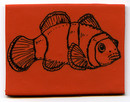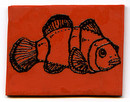Rubber Stamp Techniques for Polymer Clay
So you've stocked up on all the right supplies for stamping on polymer clay... Now what? Not all of the basic rubber stamping rules for paper apply to polymer clay. Plus there are some options for stamping polymer clay that you just don't have with paper — like using your stamp as a texture tool. Here's an overview of some different ways you can use stamps with polymer clay.
Stamping On Unbaked Clay
Stamping clay before you bake it gives you some neat texture options. It also has some slightly different rules than typical stamping. For example, when you're rubber stamping on paper, rocking the stamp back and forth is a big no-no (it's likely to cause smears and double lines). But it's okay to do a little rocking when you're stamping polymer clay. In fact, do whatever you need to do to get a really deep impression. I often stamp standing up, so I can put a little more muscle into it. Here are some options for stamping unbaked clay:
 Stamp with StazOn Ink. StazOn ink is permanent on unbaked or baked clay. Stamping with StazOn ink before baking the clay is a good choice if you want a textured image with ink. It's easy to do, too. First, roll out your clay to the desired thickness on your pasta machine. Apply ink to the stamp. I like to lay my stamp face-up, then dab on ink from the ink pad til the stamp is completely covered. Then press your stamp into the clay.
Stamp with StazOn Ink. StazOn ink is permanent on unbaked or baked clay. Stamping with StazOn ink before baking the clay is a good choice if you want a textured image with ink. It's easy to do, too. First, roll out your clay to the desired thickness on your pasta machine. Apply ink to the stamp. I like to lay my stamp face-up, then dab on ink from the ink pad til the stamp is completely covered. Then press your stamp into the clay. Stamp with Pearl Ex Powders. Stamping unbaked clay with Pearl Ex powders gives you texture with a subtle glimmer. The trick is to lightly mist the stamp with water (or try making a "stamp pad" from a folded wet paper towel), then use your finger or a paintbrush to apply a light dusting of powder to the damp stamp.
Stamp with Pearl Ex Powders. Stamping unbaked clay with Pearl Ex powders gives you texture with a subtle glimmer. The trick is to lightly mist the stamp with water (or try making a "stamp pad" from a folded wet paper towel), then use your finger or a paintbrush to apply a light dusting of powder to the damp stamp.- "Dry Stamp". If you just want the stamp's texture, you can stamp without any inks or powders. Then after baking, you can highlight this texture by either pressing paint into the crevices (antiquing) or adding a surface treatment to just the raised areas (by dry brushing, using Rub 'n Buff, etc.)
 Sutton Slice Technique. This is an interesting technique where you press clay into the stamp, then add a second clay color to show the contrast. Check out these Sutton Slice instructions on HGTV for more info.
Sutton Slice Technique. This is an interesting technique where you press clay into the stamp, then add a second clay color to show the contrast. Check out these Sutton Slice instructions on HGTV for more info.
Stamping On Baked Clay
Stamping clay after baking is more like stamping on paper — you've got to be careful to get a clean, firm impression the first time without any rocking. There's a couple of different ink options when you stamp after baking: Stamp with StazOn Ink. If you stamp with StazOn inks after baking, the stamped image will be waterproof, but it still may smear if exposed to alcohol. Heat setting the inks in the oven solved that problem for me.
Stamp with StazOn Ink. If you stamp with StazOn inks after baking, the stamped image will be waterproof, but it still may smear if exposed to alcohol. Heat setting the inks in the oven solved that problem for me. Stamp with Pigment Ink and Emboss. While pigment inks will never dry on polymer clay on their own, you can use these inks with embossing powder, and set them with a heat gun. This creates a cool raised image on the clay. I highly recommend doing this only after baking, though. Embossing powders stick to unbaked clay, making it almost impossible to get a clean embossed image.
Stamp with Pigment Ink and Emboss. While pigment inks will never dry on polymer clay on their own, you can use these inks with embossing powder, and set them with a heat gun. This creates a cool raised image on the clay. I highly recommend doing this only after baking, though. Embossing powders stick to unbaked clay, making it almost impossible to get a clean embossed image.
Other Stamping Hints
- Image Cut-outs: You can cut out individual stamped elements either before (using clay blade, cookie cutter) or after (using scissors, craft knife) baking. It's often easier to smooth the edges if you cut the clay before baking.
- Work Surface Tip: If you're planning to make a really deep impression with your stamp, consider working on a surface you can also bake on. It can be tricky to transfer these stamped sheets without distorting or tearing them.
Of course, these tips just brush the surface. As you experiment, you'll find plenty of interesting things to do with rubber stamps and polymer clay. And you can often find new ideas and inspiration in regular (non-clay) rubber stamping technique books. In my next post, for example, I'll show you how to use a masking technique on a polymer clay coaster project.
Did I leave out a favorite technique of yours? Leave me a comment...
Posts in This Series:- Rubber Stamping Basics for Polymer Clay
- Rubber Stamp Techniques for Polymer Clay
- How to Make a Rubber Stamped Coaster
- Video: How to Heat Emboss on Polymer Clay
- How to Make an Ultrasound Frame





Comments
That Sutton Slice technique is a real cool one Angela! I saw that a long time ago but since I did not try it at the time I completely forgot about it! Will have to give it a try and see if I can do it right! Thank you for the reminder.
All the other tips are great BTW! Good job!
Posted by: Cindy Lietz, Polymer CLay Tutor | July 26, 2008 7:56 PM
Thanks, Cindy. One thing I forgot to mention: I've found the Sutton Slice technique much easier to do with unmounted rubber stamps, since they're flexible. Good luck -- I would love to see how it turns out!
Posted by: Angela Mabray | July 26, 2008 11:42 PM
I am certainly glad I read your review of the Sculpey 4 in one clay blade set. I did not get any clue from the directions either and it didn't occur to me to take the handles apart until I read your review and finally saw the video on line! Thanks to you, I did not slice my hands trying to snap the handles on these blades! I owe you a lot! LOL!
Kathy
Posted by: Kathy | June 15, 2011 7:18 PM
I'm so glad my review was helpful, Kathy, and especially that it saved you some finger-slicing! Here's a link to the 4-in-1 blade review in case anyone else is interested.
Posted by: Angela Mabray | June 30, 2011 3:53 PM